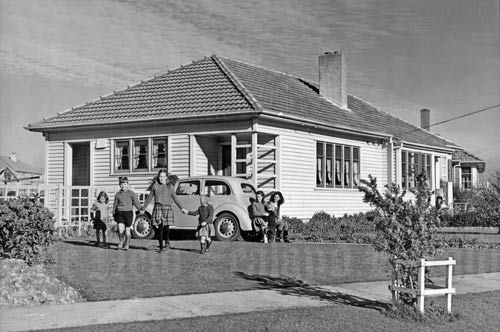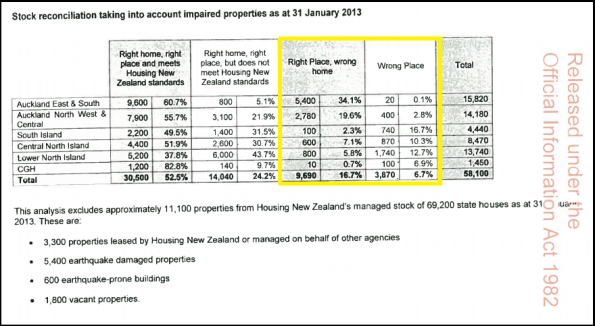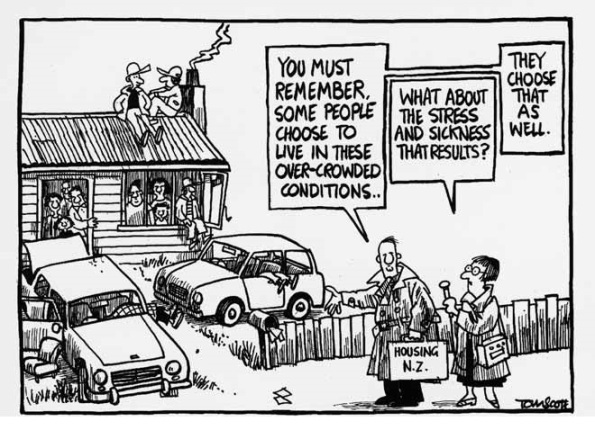State houses – “wrong place, wrong size”?
.
.
Information released under the Official Information Act (OIA) suggests that National’s oft-repeated claim that around “one third” ( or 22,000) of state houses are in the “wrong place and wrong size” is not supported by Housing NZ’s own figures.
Various ministers, including our esteemed Dear Leader, have indicated that up to “a third” of state houses are “in the wrong place or wrong size (or ‘type’)“.
The “wrong size/wrong place” claim is the argument being used by National to advance a major sell-off of Housing NZ properties.
On 1 November, 2014, Social Housing Minister Paula Bennett said on TV3’s ‘The Nation’,
“It’s about being smart in what we’re doing. So you just look at us having the wrong houses, in the wrong place, of the wrong size..”
“Yes. As recently as just last month Housing New Zealand issued a press release that said: ‘around one third of our housing stock is in the wrong place, wrong configuration or is mismatched with future demand’.
[…]
… in fact, a third of them are the wrong size, in the wrong place, and in poor condition.”
On 28 January this year, John Key announced in his “state of the nation” speech;
“Around a third of Housing New Zealand properties are in the wrong place, or are the wrong type to meet existing and future demand.”
Housing NZ currently “manages 67,245 homes” (as at 30 June 2015). When Key, and other National ministers refer to “around a third of Housing NZ properties”, simple arithmetic translates that fraction into 22,190 homes being the “wrong size/wrong place” .
On 17 September I lodged OIA requests to Ministers Nick Smith, Paula Bennet, and Bill English. Only English was prepared to answer – and even that took 42 days (30 working days) to eventuate after a reminder was emailed to the Minister’s office.
In a response eventually received on 29 October, information in the form of a chart -“Stock reconciliation taking into account impaired properties as at 31 January 2013” – was attached;
.
.
In two columns headed “Right Place, wrong home” and “Wrong Place“, the respective figures add up to 13,560. This constitutes a little over half of the “22,000” that is being bandied about by National.
I specifically asked Bill English; “How many [state houses] are the “wrong size“ and in what manner are they the “wrong size“? “Do they have too many rooms; too few rooms?”
English replied;
“In general terms, Housing New Zealand has a shortage of smaller two bedroom homes and
larger family homes and a surplus of three bedroom homes, with the exception of Auckland
where there is a demand for homes of all sizes. The type or configuration of particular
properties may also affect demand making them difficult to let.”
English totally ignored the direct question “How many [state houses] are the “wrong size“. He either does not know, or is unwilling to admit the number. “In General terms” is not a specific quantity.
Furthermore, English says that “Housing New Zealand has a shortage of smaller two bedroom homes and larger family homes and a surplus of three bedroom homes, with the exception of Auckland where there is a demand for homes of all sizes.”
Unsurprisingly, the 2014/15 Housing NZ Annual Report confirms the high demand for housing in Auckland;
“Across the country we also have too many three-
bedroom properties, while demand has grown for smaller
one- or two-bedroom homes or for much bigger homes.
Demand for homes in the Auckland region is high and
more Housing New Zealand homes are needed.” (p22)
Yet, the chart referred above (“Stock reconciliation taking into account impaired properties as at 31 January 2013“) states that there are 8,180 houses in the Auckland region that are supposedly “Right Place, wrong home” and a further 420 that are in the “Wrong Place” – 8,600 in total.
This would appear to contradict the Minister’s assertion that “there is a demand for homes of all sizes” throughout Auckland. Both cannot be right.
This contradiction is further compounded by the fact that, as of 30 June, there were 2,267 people on the waiting list in the Auckland City area;
.
Even where houses have been the wrong size, Housing NZ has been undertaking a programme to add extensions, or entire new, smaller dwellings on larger sections;
“Overcrowding is an issue that affects many of our
tenants’ health and wellbeing, especially in Auckland,
where there is high demand for larger homes. Our
bedroom extensions programme is helping to meet
demand from the social housing register in Auckland
by converting three-bedroom homes into four- and
five-bedroom homes. Adding an extra one or two
bedrooms (and another bathroom where necessary)
means more of our tenants are living in appropriately
sized and healthier homes. During 2014/15 we
completed bedroom extensions to 247 homes.Our existing land in Auckland will also house more small
families, couples and single people in need. We are
building new two-bedroom homes on Auckland sections
that are big enough to have another dwelling. During
2014/15 we built an additional 107 two-bedroom units
on existing Housing New Zealand sections, which also
included making improvements to the existing homes
where these were required.“(p23)
If we substract the 8,600 homes in the Auckland region, from Housing NZ’s original estimate of 13,560 (see above chart), this leaves 4,960 houses “wrong place/wrong size”.
Nearly five thousand homes supposedly in the “wrong place/wrong size” category in Auckland – and there are still 2,267 people on Housing NZ’s waiting list in Auckland City. How is that feasible?
I further enquired from English; “Could you please explain what the term “wrong size, in the wrong place” actually refers to? Where are they situated that are considered the “wrong place“?”
English replied;
“In 2011 Housing NZ carried out an assessment of it’s future projected stock
requirements for the purpose of forward planning, based on its future use of intention of its
properties and informed by demand forecasting. This assessment was not intended to reflect
current demand at a point in time…[..]
The analysis identifies some properties as being the wrong home, not specifically the wrong
size.”
It is worthwhile noting English’s comment that “Housing NZ carried out an assessment of it’s future projected stock requirements for the purpose of forward planning, [but] this assessment was not intended to reflect current demand at a point in time”.
The apparent purpose? According to English’s 29 October statement to me;
“This relates to the number of bedrooms that a property has and also includes
properties that are wrongly configured to meet demand for social housing.“
“Social housing” is National’s code for private providers.
The 2011 Housing NZ assessment of it’s “future projected stock” appears to have been designed to meet the needs of “social housing”, aka private providers.
In respect to answering my question “Where are they situated that are considered the “wrong place”?”, English’s response was vague and lacked any informative value (as did many of his answers);
“A property being in the wrong place refers to the location of the property in relation
to demand. On a regional basis, there are areas of general low demand. However, some of
Housing New Zealand’s properties may be in locations with high concentrations of state
housing or existing social issues that may contribute to them being difficult to let or
result in a high turnover of tenants.”
There were no geographical locations; no cities or towns; no suburbs given. The statement in itself is meaningless twaddle with a vague reference to “some of Housing New Zealand’s properties may be in locations with high concentrations of state housing or existing social issues”.
Where these “wrong places” might be is anyone’s guess.
My follow-up question – “How many areas have been designated “wrong places”?” – was ignored entirely.
In an effort to drill down and assess where houses might be in the “wrong place”, I asked English; “where houses are in a particular “wrong place”, how many people are on HNZ waiting lists in those same “wrong places”?
The purpose of this question was straight-forward. Where demand for housing is high in a given region, it seems inconceivable that any properties in that same region would be in the “wrong place”. Auckland being a prime example.
I wanted to know how many other regions had high numbers on their waiting lists – whilst also having houses in the “wrong place”.
According to the above chart, the following regions designated as having houses in the “wrong places” have the following numbers of houses attached to them;
Auckland: 420
South Island: 740
Central North Island: 870
Lower North Island: 1,740
“Community Group Housing”: 100
Total: 3,870
Because of the (deliberate?) vagueness of English’s response, we have no way of knowing where, for example, the South Island’s supposed 740 houses are located in the “wrong place”.
It is difficult to understand why the Minister could not be more precise.
If the “wrong size/wrong place” issue is real, then National must have hard data, with supporting numbers, identifying where state houses are located in the “wrong place”. This information should be on-file; readily accessible; and easily released to interested parties. Then again, my OIA lodgement to Minister English took 30 working days (including one “request” for an extension) to complete.
Perhaps such data does not exist.
According to Housing NZ itself, every district within it’s authority has people on their waiting list;
.
.
There is no district recording zero-need.
I asked English; “What replacement houses are being built to replace those that are the “wrong size”, and how many rooms will they have? More? Less?” and “Where Housing NZ houses are in the “wrong place” – will new State houses be built in exactly the same place?”.
The Minister responded;
“Housing New Zealand’s Asset Management Strategy provides for the redevelopment of its
land holdings in order to align the typology, location and size of its portfolio with demand.
As a result, it is building more two, four and five bedroom properties. Where there is low
demand, Housing New Zealand will look to sell surplus properties and reinvest the proceeds
into providing homes in areas of high demand.“
As outlined above, Housing NZ has a current programme of adding bedrooms to existing three bedroomed houses, and, where the land is big enough, adding two bedroom houses onto an existing built-up section.
English’s reference to selling “surplus properties” is troubling, as we are still none-the-wiser where such properties exist. Especially when all Housing NZ districts have people on waiting lists.
As for English’s assertion that “Housing New Zealand will look to sell surplus properties and reinvest the proceeds into providing homes in areas of high demand” – Paula Bennett was not willing to give that assurance on 1 November last year, speaking on Q+A.
Which leads on to the last question I put to the Minister; “If HNZ houses that are in the “wrong place” are sold/given away to community organisations – what will make those houses suddenly become in the “right place”?”
Because if it’s in the “wrong place” when owned by Housing NZ – why would it suddenly be in the “right place” owned by someone else?
The Minister’s response was baffling;
“The Government has no plans to offer Housing New Zealand properties that have been
identified as being in the ‘wrong place’ to community housing providers. In Tauranga and
Invercargill for example, the areas identified for initial potential transfers of social
housing properties from Housing New Zealand to community housing providers, MSD’s purchasing
intentions anticipate stable demand. Following a transfer, any new provider would receive
both the properties and a contract with MSD to continue to provide social housing.”
That statement appears to be at complete variance with this undated Beehive document, headed “Social Housing Reform Programme – Media Qs and As“;
SOCIAL HOUSING REFORM PROGRAMME – Media Qs and As
“Around one third of the $18.7 billion Housing New Zealand portfolio is in
the wrong place or of the wrong type to meet this need.”[…]
“To help community housing providers grow, there will be sales of
Housing New Zealand properties and we will involve these providers
in the redevelopment of Crown land…”[…]
“Details will be determined after national engagement, including
with community housing providers and iwi,over coming months.
Providing we can achieve better services for tenants and fair
and reasonable value for taxpayers, we will look to sell
between 1,000 and 2,000 Housing New Zealand properties over
the next year.”[…]
“15. Will properties being sold be tenanted, and if so what
happens to the tenants?In most cases where houses transfer to a community housing
provider, the properties will have tenants. The new owners
will continue providing social housing with the income-
related rent subsidy.”[…]
“Look at selling between 1,000 and 2,000 Housing New Zealand
properties for continued use as social housing, run by approved
community housing providers. These providers might buy
properties on their own or go into partnership with other
organisations lending them money, contributing equity, or
providing other services.”
The document specifically refers to the sale of state housing, that are “the wrong place or of the wrong type“, to community service providers.
And in Parliament, on 24 March, Bill English himself made reference to the sale of “wrong place” Housing NZ properties to Community providers;
“In the first place, Housing New Zealand has an ongoing sales
policy, and often it is selling houses that we do not need or
that are in the wrong place, or some of them have just become
unsuitable to be lived in and cannot be upgraded at reasonable
cost. In respect of the transactions that are coming up over
the next 6 months or so, there is a process of testing what
the real values of those houses are. For instance, many
community providers believe those houses are not up to date
on maintenance, and therefore are overvalued when they are
valued as if they can be sold for the best price on the day
in the location that they are in. Those are exactly the things
we are having discussions about over the next few months.”[…]
“Neither property developers nor community housing providers
are compelled to buy houses off the Government. If they do
not want to do that—if they do not want to manage the tenants
or own the stock, which may be the wrong size in the wrong
place—then they certainly do not have to do that.”
Which creates doubt over English’s assertion that “the Government has no plans to offer Housing New Zealand properties that have been
identified as being in the ‘wrong place’ to community housing providers”.
So if Housing NZ properties that are in the “wrong place” are sold to community housing providers – as confirmed by Minister English on at least two occassions – what will transform those “wrong place” houses into “right place” houses?
Very little of National’s “wrong size/wrong place” proposition makes sense – unless viewed through the lens of raising revenue by way of partial asset-sales.
That is the only thing that makes any sense of this issue.
The only reason that the “wrong size/wrong place” meme has worked for National thus far is that very few (if anyone) has delved behind the phrase to check it’s validity.
Perhaps it is time this issue was scrutinised more carefully?
The apparent fudging of Bill English’s response to my OIA request, in itself, speaks volumes.
Postscript
On 29 October, I wrote to Bill English expressing my dissatisfaction with his response to my OIA lodgement;
from: Frank Macskasy <fmacskasy@gmail.com>
to: “B English (MIN)” <B.English@ministers.govt.nz>
date: Thu, Oct 29, 2015 at 8:01 PM
subject: Re: State houses – wrong place, wrong size
Thank you for your letter dated 29 October.
I refer you to two questions which you have not answered in my OIA request;
4. Where are they situated that are considered the “wrong place”?
5. How many areas have been designated “wrong places”?
Please advise if you do not intend to answer those questions, and I will lodge a formal complaint with the Office of the OImbudsman.
Regards,
-Frank Macskasy
Appendix1
In 2014/15 Housing NZ “returned” $321 million to the government’s Consolidated Fund. This comprised of $118 million in tax; $96 million in interest costs, and $107 million as a dividend. (2014/15 Annual Report, p24)
.
.
.
References
TV3: The Nation – Social Housing Minister Paula Bennett
Parliament: 6. State Housing—Suitability of Housing Stock
Fairfax media: John Key Speech – Next steps in social housing
Housing NZ: 2014/15 Annual Report
Housing NZ: Register by priority and Auckland local board – 30 June 2015
Beehive.govt.nz: Social Housing Reform Programme – Media Qs and As
Parliament Today: Social Housing Reform — Objectives
Other Blogs
The Jackal: More homelessness under National
Previous related blogposts
Government Minister sees history repeat – responsible for death
Housing Minister Paula Bennett continues National’s spin on rundown State Houses
Letter to the Editor – How many more children must die, Mr Key?!
National under attack – defaults to Deflection #1
Another ‘Claytons’ Solution to our Housing Problem? When will NZers ever learn?
National’s blatant lies on Housing NZ dividends – The truth uncovered!
National recycles Housing Policy and produces good manure!
National Housing propaganda – McGehan Close Revisited
Housing; broken promises, families in cars, and ideological idiocy (Part Tahi)
Housing; broken promises, families in cars, and ideological idiocy (Part Rua)
Housing; broken promises, families in cars, and ideological idiocy (Part Toru)
.
.
.
.
This blogpost was first published on The Daily Blog on 1 November 2015.
.
.
= fs =







I too would love to know what “in the wrong place” means? Could that mean here? (I am assured that just up the road from this state house street, is a posh area, and several State houses in the parallel street have been sold to young families as “starter homes”, 1950s pepper potting means that state houses are next to tony places, and a positive multi-million dollar mansion is one block away from our state houses – which the rich people don’t like at all!
Deb
I suspect there’s a strong element of that, Deb. In fact, it would be “killing three birds with one stone” by selling state houses in affluent areas;
(1) Government raises income it desperately needs to balance it’s books,
(2) Selling state houses alleviates some of the pressure of the growing housing crisis in Auckland,
(3) It satisfies the affluent families in those streets and their property values increase accordingly